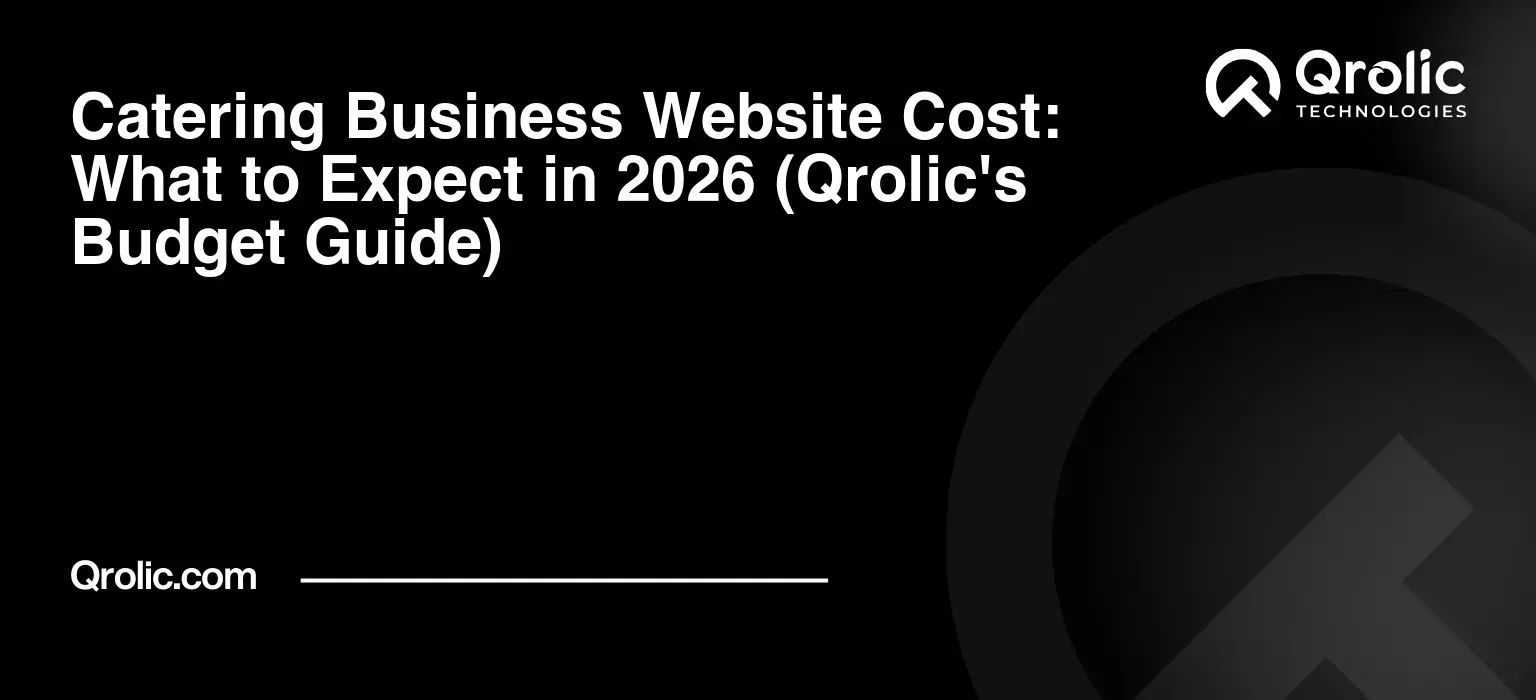Quick Summary:
- Plan your website strategy thoroughly first.
- Design with high-quality visuals and clear content.
- Optimize for search engines and mobile users.
- Promote and maintain your site for success.
Table of Contents
- 1. Laying the Foundation: Planning Your Catering Website Strategy
- 1.1. Defining Your Target Audience: Who Are You Serving?
- 1.2. Competitive Analysis: What Are Other Caterers Doing Online?
- 1.3. Defining Your Website Goals: What Do You Want to Achieve?
- 1.4. Sitemap Planning: Structuring Your Website for Success
- 2. Choosing the Right Platform: Selecting Your Catering Website Builder
- 2.1. WordPress: The Flexible Powerhouse
- 2.2. Squarespace: The Elegant All-in-One Solution
- 2.3. Wix: The Drag-and-Drop Dream
- 2.4. Other Options: Considering Alternatives
- 3. Designing a Visually Appealing Website: Capturing Your Audience’s Attention
- 3.1. Choosing a Color Palette: Setting the Mood
- 3.2. Selecting Fonts: Ensuring Readability and Style
- 3.3. High-Quality Photography: Showcasing Your Culinary Creations
- 3.4. User-Friendly Navigation: Guiding Your Visitors
- 4. Creating Compelling Content: Engaging Your Audience and Driving Conversions
- 4.1. Homepage Content: Making a Strong First Impression
- 4.2. About Us Page: Telling Your Story
- 4.3. Menu Page: Showcasing Your Culinary Delights
- 4.4. Services Page: Highlighting Your Expertise
- 4.5. Blog: Sharing Valuable Content
- 5. Optimizing for Search Engines: Getting Found Online
- 5.1. Keyword Research: Identifying Relevant Terms
- 5.2. On-Page Optimization: Optimizing Your Website Content
- 5.3. Off-Page Optimization: Building Authority and Trust
- 5.4. Local SEO: Targeting Local Customers
- 6. Essential Features and Functionality: Enhancing User Experience
- 6.1. Contact Form: Making it Easy to Connect
- 6.2. Online Booking/Inquiry System: Streamlining the Process
- 6.3. Testimonials Section: Building Trust and Credibility
- 6.4. Social Media Integration: Expanding Your Reach
- 6.5. Mobile Optimization: Catering to Mobile Users
- 7. Testing and Launching Your Website: Ensuring a Smooth Experience
- 7.1. Cross-Browser Compatibility: Ensuring Consistency
- 7.2. Mobile Responsiveness Testing: Optimizing for Mobile Devices
- 7.3. Functionality Testing: Verifying All Features
- 7.4. Speed Testing: Optimizing Performance
- 7.5. User Testing: Getting Feedback
- 7.6. Launching Your Website: Making it Live
- 8. Promoting and Maintaining Your Website: Growing Your Business
- 8.1. Content Marketing: Attracting and Engaging Your Audience
- 8.2. Social Media Marketing: Building a Community
- 8.3. Email Marketing: Nurturing Leads and Driving Sales
- 8.4. Paid Advertising: Reaching a Wider Audience
- 8.5. Website Analytics: Tracking Performance and Making Improvements
- 8.6. Regular Updates: Keeping Your Website Fresh
- 9. Qrolic Technologies: Your Partner in Digital Success
- 10. Conclusion: Building a Thriving Online Presence
1. Laying the Foundation: Planning Your Catering Website Strategy
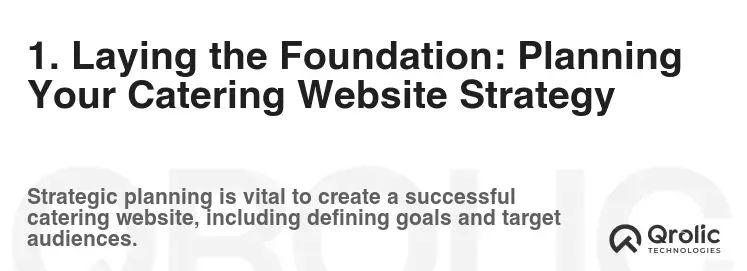
Before diving headfirst into design and code, a solid plan is crucial for building a catering company website that attracts customers and drives business. Think of it as crafting the perfect recipe – the right ingredients, measured precisely, ensure a delicious outcome.
1.1. Defining Your Target Audience: Who Are You Serving?
Understanding your ideal client is paramount. Are you targeting corporate clients for large events, wedding parties seeking elegant receptions, or families hosting intimate gatherings? Defining your niche will shape your website’s tone, design, and content.
- Corporate Events: Emphasize professionalism, efficiency, and menu options catering to diverse dietary needs.
- Wedding Parties: Showcase romance, elegance, and customizable packages with stunning visuals.
- Family Gatherings: Highlight affordability, convenience, and menus tailored to different age groups.
Actionable Tip: Create detailed customer personas. Include their demographics, needs, pain points, and online behavior. Use this information to tailor your website messaging and design. Consider what keywords they might use when searching for catering services.
1.2. Competitive Analysis: What Are Other Caterers Doing Online?
Researching your competitors provides valuable insights into industry standards, design trends, and effective marketing strategies. Identify what they’re doing well and where they’re falling short.
- Identify Competitors: Search online for catering companies in your area.
- Analyze Their Websites: Evaluate their design, content, user experience, and SEO performance.
- Identify Strengths and Weaknesses: What are they doing right? What could they improve?
- Find Opportunities: How can you differentiate your website and offer something unique?
Actionable Tip: Use SEO tools to analyze your competitors’ keywords and backlinks. This will help you identify opportunities to improve your website’s search engine ranking. Look at their pricing structures and see if there is a better offer you can make.
1.3. Defining Your Website Goals: What Do You Want to Achieve?
Clearly define what you want your website to accomplish. Do you want to generate leads, book events online, showcase your menu, or establish your brand as a leader in the catering industry?
- Lead Generation: Capture potential customer information through contact forms and email sign-ups.
- Online Booking: Allow customers to book catering services directly through your website.
- Menu Showcase: Display your menu options with high-quality images and detailed descriptions.
- Brand Building: Establish your company’s identity and build trust with potential customers.
Actionable Tip: Set specific, measurable, achievable, relevant, and time-bound (SMART) goals for your website. For example, “Increase online leads by 20% in the next quarter.”
1.4. Sitemap Planning: Structuring Your Website for Success
A well-organized sitemap ensures easy navigation and helps search engines understand your website’s structure. Plan out the key pages and their relationships to each other.
- Homepage: Your website’s main entry point, showcasing your brand and value proposition.
- About Us: Tell your company’s story, highlighting your experience and expertise.
- Menu: Display your menu options with detailed descriptions and pricing.
- Services: Outline the different catering services you offer (e.g., weddings, corporate events, private parties).
- Gallery: Showcase high-quality photos of your food and events.
- Testimonials: Display positive reviews from satisfied customers.
- Blog: Share informative content about catering trends, recipes, and event planning tips.
- Contact Us: Provide contact information and a contact form for inquiries.
Actionable Tip: Create a visual sitemap using a flowchart or mind map to visualize the website’s structure and navigation.
2. Choosing the Right Platform: Selecting Your Catering Website Builder
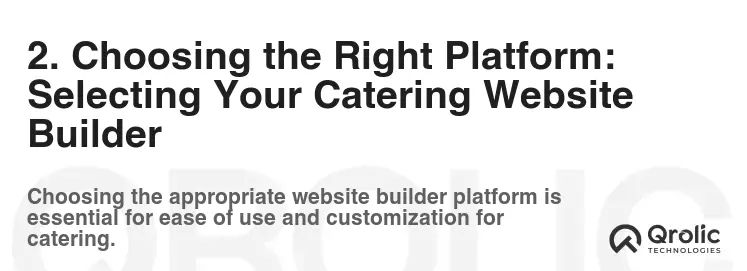
Selecting the right platform is crucial for building a catering website that meets your needs and budget. Several options are available, each with its pros and cons.
2.1. WordPress: The Flexible Powerhouse
WordPress is a popular content management system (CMS) known for its flexibility, customization options, and extensive plugin library.
- Pros: Highly customizable, SEO-friendly, vast plugin library, large community support.
- Cons: Requires some technical knowledge, can be more complex to manage than other platforms.
Why WordPress is Great for Catering: WordPress allows for complete control over your website design and functionality. You can use plugins to add features like online booking, menu management, and event calendars. Its SEO-friendly nature will help your catering website rank higher in search engine results.
Actionable Tip: Choose a WordPress theme specifically designed for catering businesses. These themes often include features like menu templates, gallery layouts, and contact forms.
2.2. Squarespace: The Elegant All-in-One Solution
Squarespace is a user-friendly website builder known for its beautiful templates and ease of use.
- Pros: Easy to use, visually appealing templates, all-in-one platform (hosting included).
- Cons: Less customizable than WordPress, limited plugin options, can be more expensive than self-hosted solutions.
Why Squarespace is Great for Catering: Squarespace offers stunning templates that are perfect for showcasing your food and event services. Its drag-and-drop interface makes it easy to create a professional-looking website without any coding knowledge.
Actionable Tip: Utilize Squarespace’s built-in SEO tools to optimize your website for search engines. Focus on using relevant keywords in your page titles, descriptions, and content.
2.3. Wix: The Drag-and-Drop Dream
Wix is a popular website builder that offers a drag-and-drop interface and a wide range of templates.
- Pros: Easy to use, drag-and-drop interface, wide range of templates, app market for adding features.
- Cons: Less customizable than WordPress, limited SEO capabilities, can be expensive as you scale.
Why Wix is Great for Catering: Wix allows you to quickly create a visually appealing website with its easy-to-use interface and drag-and-drop editor. You can add features like online ordering, booking calendars, and contact forms through the Wix App Market.
Actionable Tip: Optimize your website’s mobile responsiveness to ensure a great user experience on all devices.
2.4. Other Options: Considering Alternatives
Other website builders, such as Weebly, GoDaddy Website Builder, and Duda, may also be suitable depending on your specific needs.
- Weebly: A simple and affordable website builder with a drag-and-drop interface.
- GoDaddy Website Builder: An easy-to-use website builder integrated with GoDaddy’s hosting services.
- Duda: A website builder designed for agencies and freelancers who build websites for clients.
Actionable Tip: Research each platform thoroughly and compare their features, pricing, and ease of use before making a decision. Consider starting with a free trial to test out the platform before committing to a paid plan.
3. Designing a Visually Appealing Website: Capturing Your Audience’s Attention
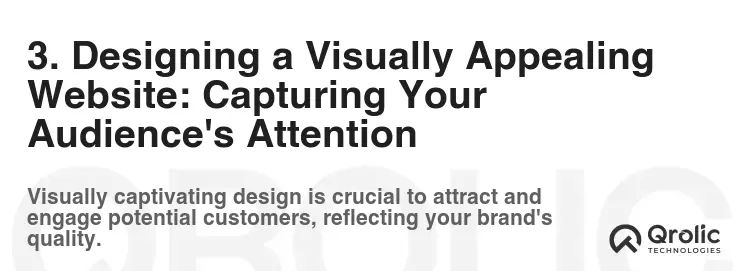
Your website’s design is crucial for creating a positive first impression and engaging potential customers. Focus on creating a visually appealing and user-friendly experience.
3.1. Choosing a Color Palette: Setting the Mood
Select a color palette that reflects your brand’s personality and evokes the desired emotions.
- Warm Colors (Red, Orange, Yellow): Create a sense of energy, excitement, and appetite.
- Cool Colors (Blue, Green, Purple): Evoke feelings of calmness, sophistication, and trust.
- Neutral Colors (White, Black, Gray): Provide a clean and modern backdrop for your content.
Actionable Tip: Use a color palette generator tool to create a cohesive and visually appealing color scheme. Consider your target audience and the type of events you cater to when choosing your colors.
3.2. Selecting Fonts: Ensuring Readability and Style
Choose fonts that are easy to read and complement your overall design aesthetic.
- Headings: Use a bold and eye-catching font to draw attention to your headings.
- Body Text: Use a clear and legible font for your body text to ensure readability.
- Font Pairing: Choose fonts that complement each other and create a visually harmonious design.
Actionable Tip: Use Google Fonts to access a wide range of free and high-quality fonts. Test your font choices on different devices and screen sizes to ensure readability.
3.3. High-Quality Photography: Showcasing Your Culinary Creations
Invest in high-quality photography to showcase your food and events. Visuals are essential for attracting customers and convincing them to choose your catering services.
- Professional Photos: Hire a professional photographer to capture stunning images of your food, events, and team.
- Food Styling: Style your food to make it look as appealing as possible.
- Event Photography: Capture candid shots of your team in action at events.
- Image Optimization: Optimize your images for the web to reduce file size and improve loading speed.
Actionable Tip: Use a consistent style for your photography to create a cohesive and professional look. Consider using a photo editing tool to enhance your images and ensure they are consistent in color and lighting.
3.4. User-Friendly Navigation: Guiding Your Visitors
Ensure your website is easy to navigate and that visitors can quickly find the information they are looking for.
- Clear Menu: Use a clear and concise menu to guide visitors to the different sections of your website.
- Search Bar: Include a search bar to allow visitors to quickly find specific information.
- Call-to-Action Buttons: Use clear and prominent call-to-action buttons to encourage visitors to take action (e.g., “Get a Quote,” “Book Now,” “Contact Us”).
- Mobile Responsiveness: Ensure your website is fully responsive and looks great on all devices.
Actionable Tip: Test your website’s navigation with real users to identify any usability issues. Use analytics tools to track how visitors are using your website and identify areas for improvement.
4. Creating Compelling Content: Engaging Your Audience and Driving Conversions
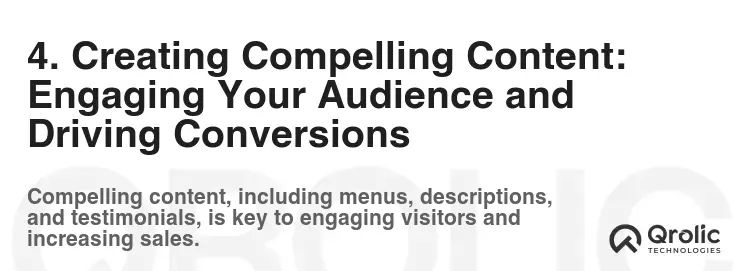
Your website’s content is crucial for engaging your audience, building trust, and driving conversions. Focus on creating informative, persuasive, and SEO-friendly content.
4.1. Homepage Content: Making a Strong First Impression
Your homepage is your website’s main entry point, so it’s essential to make a strong first impression.
- Headline: Use a compelling headline that clearly communicates your value proposition.
- Value Proposition: Explain what makes your catering company unique and why customers should choose you.
- Call to Action: Include a clear call to action that encourages visitors to take the next step (e.g., “Get a Free Quote,” “Browse Our Menu,” “Contact Us”).
- High-Quality Images: Use high-quality images to showcase your food and events.
Actionable Tip: Keep your homepage content concise and easy to read. Use bullet points and short paragraphs to break up the text and make it more scannable.
4.2. About Us Page: Telling Your Story
Your About Us page is an opportunity to tell your company’s story and build trust with potential customers.
- Company History: Share your company’s history and how it was founded.
- Mission and Values: Explain your company’s mission and values.
- Team Members: Introduce your team members and highlight their expertise.
- Customer Testimonials: Include positive reviews from satisfied customers.
Actionable Tip: Use a personal and engaging tone to connect with your audience on an emotional level. Share your passion for catering and your commitment to providing exceptional service.
4.3. Menu Page: Showcasing Your Culinary Delights
Your menu page is where you showcase your culinary creations and entice potential customers.
- High-Quality Images: Use high-quality images to showcase your food.
- Detailed Descriptions: Provide detailed descriptions of each menu item, including ingredients, preparation methods, and dietary information.
- Pricing: Clearly display the pricing for each menu item.
- Categorization: Organize your menu items into categories for easy browsing.
Actionable Tip: Make your menu easy to download and print. Consider offering customizable menu options to cater to different dietary needs and preferences.
4.4. Services Page: Highlighting Your Expertise
Your services page is where you outline the different catering services you offer.
- Detailed Descriptions: Provide detailed descriptions of each service, including what’s included and the types of events you cater to.
- Target Audience: Specify the target audience for each service (e.g., weddings, corporate events, private parties).
- Pricing: Clearly display the pricing for each service or offer custom quotes.
- Call to Action: Include a call to action that encourages visitors to inquire about your services (e.g., “Get a Quote,” “Book a Consultation,” “Contact Us”).
Actionable Tip: Showcase your expertise by including case studies or examples of past events you’ve catered to.
4.5. Blog: Sharing Valuable Content
A blog is a great way to share valuable content with your audience, establish your expertise, and improve your website’s SEO.
- Catering Trends: Write about the latest catering trends and innovative ideas.
- Recipes: Share delicious recipes that your audience can try at home.
- Event Planning Tips: Provide tips and advice on planning successful events.
- Behind-the-Scenes Content: Share behind-the-scenes glimpses of your catering operations.
Actionable Tip: Create a content calendar to plan your blog posts in advance. Promote your blog posts on social media to reach a wider audience.
5. Optimizing for Search Engines: Getting Found Online
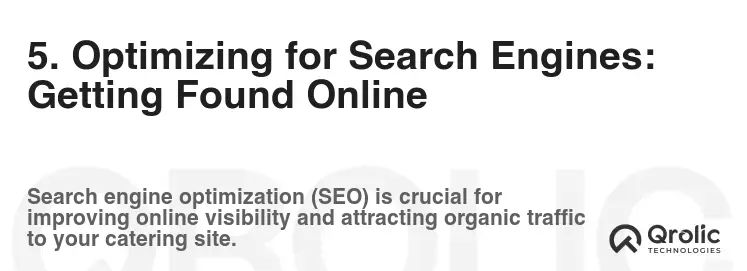
SEO is crucial for attracting organic traffic to your website and increasing your online visibility.
5.1. Keyword Research: Identifying Relevant Terms
Keyword research is the foundation of any successful SEO strategy. Identify the keywords that your target audience is using to search for catering services.
- Brainstorming: Brainstorm a list of keywords related to your catering services and target audience.
- Keyword Tools: Use keyword research tools like Google Keyword Planner, SEMrush, and Ahrefs to identify relevant keywords with high search volume and low competition.
- Long-Tail Keywords: Focus on long-tail keywords (longer, more specific phrases) to target niche audiences and improve your chances of ranking.
Actionable Tip: Create a keyword matrix that maps your target keywords to specific pages on your website.
5.2. On-Page Optimization: Optimizing Your Website Content
On-page optimization involves optimizing your website’s content and HTML code to improve its search engine ranking.
- Title Tags: Optimize your title tags with relevant keywords.
- Meta Descriptions: Write compelling meta descriptions that accurately summarize your page content.
- Header Tags: Use header tags (H1, H2, H3, etc.) to structure your content and highlight important keywords.
- Image Alt Text: Add descriptive alt text to your images to improve accessibility and SEO.
- Internal Linking: Link to other relevant pages on your website to improve navigation and SEO.
- Content Quality: Create high-quality, informative, and engaging content that is optimized for your target keywords.
Actionable Tip: Use an SEO plugin like Yoast SEO or Rank Math to help you optimize your website for search engines.
5.3. Off-Page Optimization: Building Authority and Trust
Off-page optimization involves building your website’s authority and trust through external factors like backlinks and social media.
- Backlinks: Earn backlinks from reputable websites in your industry.
- Social Media: Promote your website and content on social media platforms.
- Online Directories: List your business in online directories like Yelp and Google My Business.
- Reputation Management: Monitor your online reputation and respond to reviews.
Actionable Tip: Focus on building high-quality backlinks from relevant and authoritative websites.
5.4. Local SEO: Targeting Local Customers
Local SEO is crucial for attracting customers in your local area.
- Google My Business: Claim and optimize your Google My Business listing.
- Local Keywords: Use local keywords in your website content and meta tags.
- Local Citations: List your business in local online directories.
- Reviews: Encourage customers to leave reviews on your Google My Business listing and other review sites.
Actionable Tip: Use a consistent NAP (Name, Address, Phone Number) across all online platforms.
6. Essential Features and Functionality: Enhancing User Experience
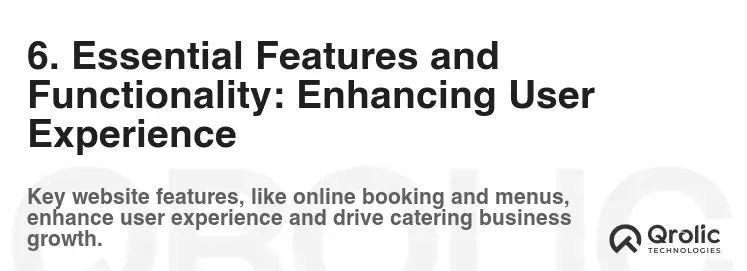
Implementing essential features and functionality will enhance the user experience and make your website more effective.
6.1. Contact Form: Making it Easy to Connect
A contact form is essential for allowing potential customers to easily connect with you.
- Required Fields: Include required fields for name, email address, and message.
- Captcha: Add a captcha to prevent spam submissions.
- Confirmation Message: Display a confirmation message after the form is submitted.
- Email Notifications: Configure email notifications to alert you when a new form is submitted.
Actionable Tip: Keep your contact form short and easy to use. Avoid asking for unnecessary information.
6.2. Online Booking/Inquiry System: Streamlining the Process
An online booking or inquiry system can streamline the process of booking catering services and generating leads.
- Availability Calendar: Display your availability calendar to allow customers to see when you’re available.
- Service Selection: Allow customers to select the catering services they’re interested in.
- Customization Options: Offer customization options for menus and event details.
- Payment Integration: Integrate with a payment gateway to allow customers to pay online.
- Automated Email Notifications: Send automated email notifications to confirm bookings and provide reminders.
Actionable Tip: Integrate your online booking system with your calendar and CRM to streamline your workflow.
6.3. Testimonials Section: Building Trust and Credibility
A testimonials section is a powerful way to build trust and credibility with potential customers.
- Authentic Testimonials: Include authentic testimonials from satisfied customers.
- Photos: Include photos of the customers who provided the testimonials.
- Details: Include details about the event or service that the customer is referring to.
- Placement: Place your testimonials prominently on your website.
Actionable Tip: Regularly update your testimonials section with new reviews.
6.4. Social Media Integration: Expanding Your Reach
Social media integration can help you expand your reach and engage with your audience.
- Social Sharing Buttons: Add social sharing buttons to your website to allow visitors to easily share your content on social media.
- Social Media Feed: Embed your social media feed on your website to display your latest posts.
- Follow Buttons: Add follow buttons to encourage visitors to follow you on social media.
Actionable Tip: Promote your website and content on social media platforms.
6.5. Mobile Optimization: Catering to Mobile Users
Mobile optimization is crucial for ensuring a great user experience on all devices.
- Responsive Design: Use a responsive design that adapts to different screen sizes.
- Mobile-Friendly Navigation: Use a mobile-friendly navigation menu.
- Fast Loading Speed: Optimize your website for fast loading speed on mobile devices.
- Touch-Friendly Elements: Use touch-friendly elements like buttons and links.
Actionable Tip: Test your website on different mobile devices to ensure it looks and functions correctly.
7. Testing and Launching Your Website: Ensuring a Smooth Experience
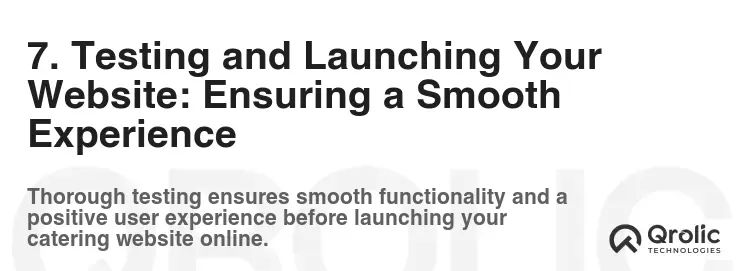
Before launching your website, it’s essential to test it thoroughly to ensure a smooth user experience.
7.1. Cross-Browser Compatibility: Ensuring Consistency
Test your website on different web browsers (e.g., Chrome, Firefox, Safari, Edge) to ensure it looks and functions correctly.
7.2. Mobile Responsiveness Testing: Optimizing for Mobile Devices
Test your website on different mobile devices and screen sizes to ensure it is fully responsive.
7.3. Functionality Testing: Verifying All Features
Test all of your website’s features and functionality, including contact forms, online booking systems, and payment integrations.
7.4. Speed Testing: Optimizing Performance
Use a Website Speed testing tool like Google PageSpeed Insights or GTmetrix to test your website’s loading speed. Optimize your images, code, and server configuration to improve performance.
7.5. User Testing: Getting Feedback
Ask friends, family, or colleagues to test your website and provide feedback on the user experience.
7.6. Launching Your Website: Making it Live
Once you’ve tested your website thoroughly and are confident that it’s ready to launch, it’s time to make it live.
- Choose a Domain Name: Select a domain name that is easy to remember and relevant to your business.
- Choose a Hosting Provider: Choose a reliable hosting provider that can handle your website’s traffic.
- Upload Your Website Files: Upload your website files to your hosting server.
- Configure Your DNS Settings: Configure your DNS settings to point your domain name to your hosting server.
- Submit Your Website to Search Engines: Submit your website to search engines like Google and Bing.
8. Promoting and Maintaining Your Website: Growing Your Business
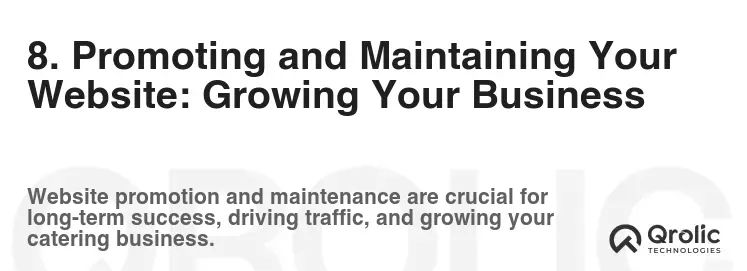
Once your website is live, it’s important to promote it and maintain it to grow your business.
8.1. Content Marketing: Attracting and Engaging Your Audience
Create and share valuable content on your website and social media platforms to attract and engage your target audience.
8.2. Social Media Marketing: Building a Community
Use social media marketing to build a community around your brand and connect with potential customers.
8.3. Email Marketing: Nurturing Leads and Driving Sales
Use email marketing to nurture leads and drive sales. Build an email list and send regular newsletters and promotional emails.
8.4. Paid Advertising: Reaching a Wider Audience
Use paid advertising platforms like Google Ads and social media ads to reach a wider audience and generate leads.
8.5. Website Analytics: Tracking Performance and Making Improvements
Use website analytics tools like Google Analytics to track your website’s performance and identify areas for improvement. Monitor your website traffic, keyword rankings, and conversion rates.
8.6. Regular Updates: Keeping Your Website Fresh
Regularly update your website’s content, design, and functionality to keep it fresh and engaging. Fix any bugs or issues that arise.
9. Qrolic Technologies: Your Partner in Digital Success
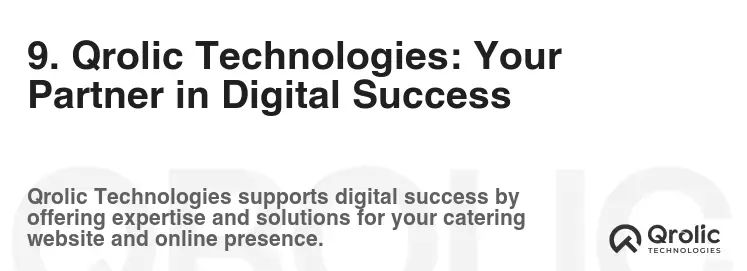
Qrolic Technologies (https://qrolic.com/) is a leading provider of digital marketing and web development services. We can help you create a stunning and effective catering company website that attracts customers and drives business.
How Qrolic Technologies Can Help:
- Website Design and Development: We create custom catering websites that are visually appealing, user-friendly, and SEO-optimized.
- SEO Services: We help you improve your website’s search engine ranking and attract more organic traffic.
- Content Marketing: We create engaging content that resonates with your target audience and drives conversions.
- Social Media Marketing: We help you build a strong social media presence and connect with potential customers.
- PPC Advertising: We manage your PPC campaigns to generate leads and drive sales.
Why Choose Qrolic Technologies:
- Experience: We have years of experience in the digital marketing and Web Development industry.
- Expertise: Our team of experts is highly skilled and knowledgeable in the latest digital marketing trends and technologies.
- Results-Driven: We are focused on delivering results that help you grow your business.
- Customer-Focused: We are committed to providing excellent customer service and support.
Contact Qrolic Technologies today to learn more about how we can help you create a successful catering company website.
10. Conclusion: Building a Thriving Online Presence
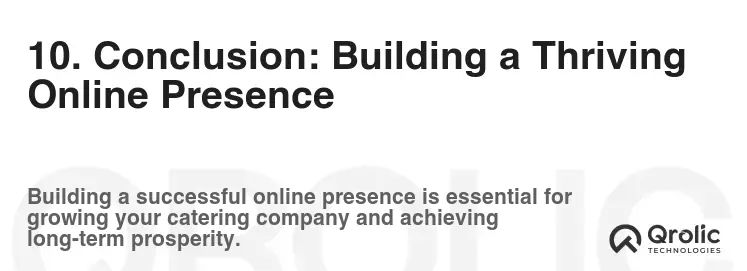
Creating a successful catering company website requires careful planning, attention to detail, and a commitment to ongoing maintenance and promotion. By following the steps outlined in this guide, you can build a website that attracts customers, drives business, and establishes your brand as a leader in the catering industry. Remember to focus on providing a great user experience, optimizing for search engines, and creating compelling content. Good luck!



